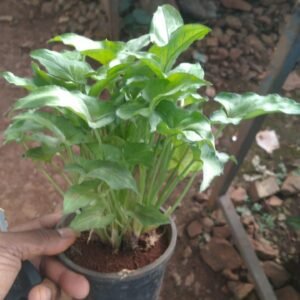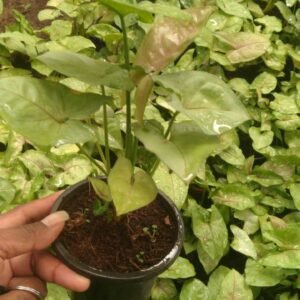Alocasia, often referred to as the African Mask Plant or Elephant Ear, is a captivating genus of tropical plants known for their dramatic foliage and striking appearance. With over 79 species, Alocasia plants are native to tropical and subtropical regions of Asia and Australia, and they have become increasingly popular among houseplant enthusiasts for their unique shapes and vibrant colors. Let’s dive into the characteristics, care tips, and allure of Alocasia plants.
Overview of Alocasia
Alocasia plants are recognized for their large, arrow-shaped leaves that can vary in color from deep green to silver and even dark purple, depending on the species. The leaves often have prominent veins and a glossy finish, giving them an almost otherworldly appearance. The plant typically grows in a rosette form, with leaves emerging from a central point, creating a lush and dramatic display.
One of the most popular species is Alocasia amazonica, commonly known as the African Mask Plant, which features stunning, elongated leaves with striking white veins that contrast beautifully against its dark green surface.
Care and Maintenance
Caring for Alocasia plants requires attention to their specific needs, but with the right care, they can thrive and become a focal point in any indoor space. Here are some essential tips for keeping your Alocasia healthy:
Light Requirements
Alocasia plants prefer bright, indirect light but can tolerate some direct sunlight, especially in the morning. However, too much direct sunlight can scorch their leaves. If the light is too low, you may notice slow growth and leggy stems, while bright light encourages robust growth and vibrant colors.
Watering
Watering Alocasia plants requires a careful balance. They like their soil to be consistently moist but not soggy. Allow the top inch of soil to dry out before watering again. Overwatering can lead to root rot, so ensure the pot has proper drainage. During the growing season (spring and summer), Alocasia plants will require more frequent watering, while in fall and winter, you can reduce watering as the plant’s growth slows.
Humidity
One of the critical factors for the success of Alocasia plants is humidity. They thrive in high humidity environments, ideally around 60% or higher. If you live in a dry climate or during winter months, consider using a humidifier, placing the pot on a pebble tray filled with water, or misting the leaves regularly to maintain humidity levels.
Soil
Alocasia plants prefer a well-draining potting mix that retains some moisture without becoming waterlogged. A mix of potting soil, peat moss, and perlite or orchid bark works well, ensuring adequate drainage and aeration for the roots.
Propagation
Propagation of Alocasia can be done through offsets or division. When the plant grows larger, it may produce offsets or “pups” at the base, which can be carefully separated and potted individually. It’s best to propagate during the growing season when the plant is actively growing.
Potential Issues
While Alocasia plants are generally hardy, they can be susceptible to pests such as mealybugs, spider mites, and aphids. Regularly inspecting your plant and wiping down the leaves can help prevent infestations. If pests are found, treating them with insecticidal soap or neem oil can help manage the problem.
Aesthetic Appeal
Alocasia plants are prized for their dramatic appearance and can serve as a stunning focal point in any room. Their large leaves create an exotic ambiance, making them perfect for both modern and traditional decor styles. They can be used as statement pieces in living rooms, offices, or as part of indoor gardens.
Benefits of Alocasia
In addition to their aesthetic appeal, Alocasia plants offer several benefits:
- Air Purification: Alocasia plants are known to help purify the air by removing toxins, contributing to improved indoor air quality.
- Unique Decorative Element: With their striking leaves and bold presence, Alocasia plants can elevate the overall decor of a space, adding a touch of elegance and nature.






Reviews
There are no reviews yet.